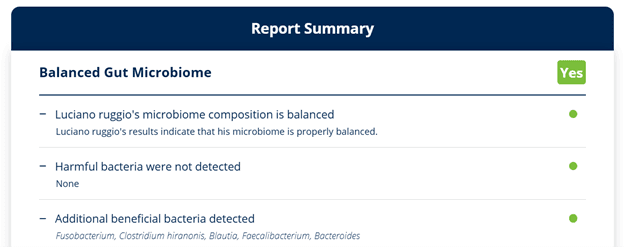With So Many Dog Food Options, What’s Actually Healthy?
Al
Ever stare at your dog’s food bag and wonder, “Is this actually good for them?”
If you’ve ever stood frozen in the pet food aisle—eyes glazing over at kibble, raw, freeze-dried, grain-free, boutique blends—you’re not alone. Every bag screams “natural,” “balanced,” or “vet-approved” but let’s be honest: most of us are still guessing what’s actually good for our dogs.
Here’s the truth:
Many commercial dog foods are loaded with questionable ingredients that can quietly chip away at your pup’s health over time.
Whether you’re raising a rowdy puppy, fueling an active adult, or supporting a sweet senior dog, understanding what goes in their bowl is non-negotiable.
In this post, I’ll break down:
- The most toxic dog food ingredients to avoid
- What to look for on labels (and what’s just fluff)
- What I feed my own service dog, Luciano
- And the surprising results of Luciano's gut microbiome test—which might just change how you think about wellness from the inside out
Let’s dig in. 🐾

Toxic Ingredients to Avoid in Dog Food
Here are the ingredients that should never make it into your dog’s food bowl:
Meat Meal: This ingredient often consists of rendered animal scraps, including diseased or dead animals. When selecting dry dog food or wet dog food, prioritize options with a named protein source, like chicken or salmon. Instead of vague terms like “meat meal.”
Propylene Glycol: Found in some semi-moist foods. This ingredient is used to keep food moist but can be toxic to dogs in large amounts. When choosing the type of food for your dog, opt for options without this chemical.
Xylitol: A common artificial sweetener, xylitol is extremely dangerous for dogs. It can cause a life-threatening drop in blood sugar and liver damage. Always check treat labels and avoid any pet food brands that use xylitol.
Artificial Colors: Artificial colors can cause allergic reactions, behavior problems, and even cancer. Stick with natural, healthy dog food options for your pup.
BHA and BHT: These artificial preservatives are used to extend shelf life. These preservatives have been linked to cancer in humans and animals. Look for natural preservatives like mixed tocopherols (vitamin E) when selecting the best dog food brands.
Carrageenan: Often found in canned or wet dog food, this thickener has been linked to digestive issues and even cancer. Choosing grain-free diets or dry kibble can help avoid this ingredient, but always check the label.

What to Look for in Dog Food Labels
When choosing the best dog food for your pup, pay attention to these key factors to ensure a balanced diet that meets their nutritional requirements:
Named Protein as the First Ingredient: Dogs are primarily carnivorous, so a high-quality protein should be the main ingredient. Think: “chicken,” “beef,” “lamb.” Avoid vague terms like “animal fat” or “meat meal.
Balanced Nutrition: Choose foods that meet the nutritional requirements established by the Association of American Feed Control Officials (AAFCO). Labels should state that the food provides “complete and balanced nutrition.”
Tailored for Activity Levels: Your dog’s energy needs vary based on their activity levels, life stage, and size. Puppy food, adult dog food, and senior dog diets should be formulated to meet their specific needs for vitamins and minerals.
Clear Ingredient List: Look for transparency in the ingredient list. Avoid foods with excessive fillers, artificial additives, or vague terms like “by-products.” High-quality dry kibble or wet dog food should list all ingredients clearly.
Natural Preservatives: Avoid artificial preservatives like BHA and BHT. Look for foods preserved naturally with ingredients like vitamin E or mixed tocopherols.
Want a deeper dive into label decoding? Check out our blog post, "Identifying Harmful Ingredients in Dog Food"—it breaks down exactly what to avoid and how to choose the best food for your pup’s long-term health.
Why I Had Luciano’s Gut Microbiome Tested
For the past few years, I’ve been overhauling our household:
- Non-toxic cleaning products ✔
- Clean personal care ✔
- Nutrient-dense meals ✔
And then I thought—what about Luciano?
Turns out, 1 in 3 dogs lives with some kind of gut imbalance. I didn’t want to wait for symptoms—I wanted to know now.

What’s a Dog Gut Microbiome Test?
Think of it as a deep-dive into your dog’s internal ecosystem. Their gut bacteria impact:
- Digestion
- Immune health
- Skin issues
- Mood and behavior
- Nutrient absorption
Over 5 in 6 dogs tested show some kind of imbalance—whether it’s too little of the good stuff or too much of the bad.
My Process
I used AnimalBiome Veterinary (through our vet) to test Luciano’s gut microbiome. The process was simple—just a stool sample and a short wait.
His Results?
✨ Balanced gut
🛑 No harmful bacteria
🎉 Healthy colonies of Bacteroides, Blautia, Fusobacterium & Faecalibacterium

Translation: He’s thriving. His food is working, and his system is supporting energy, digestion, and immune health beautifully.
And while we didn’t need to make any changes, the peace of mind is priceless.
Would I Recommend This Test?
Absolutely. Especially if your dog:
- Has chronic skin or GI issues
- Has been on antibiotics
- Is aging
- Or if you just want peace of mind
Remember: Wellness isn’t just what you see—it’s what’s happening under the surface.
Final Thoughts
Choosing the best dog food can feel like a full-time job—but it doesn’t have to.
Skip the marketing fluff and look for real ingredients, transparency, and formulas that make sense for your dog’s life stage, activity level, and size. Whole-food diets—raw, air-dried, or gently cooked—can offer huge benefits when done right.
If you want to learn more on health tips for your dog check out our Blog Post “What if your dog could live 30–50% longer… and healthier?”
💬 Want to Dive Deeper?
Need help navigating the confusing world of dog food?
Contact me HERE and let’s talk about your dog’s unique needs.
